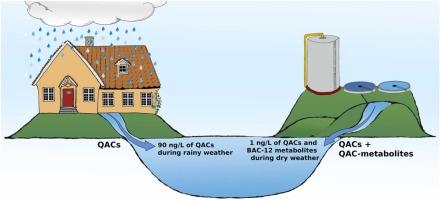季铵化合物是否通过废水或城市径流排放到地表水中?
IF 11.3
1区 环境科学与生态学
Q1 ENGINEERING, ENVIRONMENTAL
引用次数: 0
摘要
季铵化合物(QACs)如苯扎氯铵(BACs)被用于人类卫生、食品生产和建筑保护。然而,屋顶上的使用很受欢迎,但却是非法的。QACs进入接收方的主要途径有两种:1)在人体卫生方面的合法使用和通过废水排放;2)在屋顶上的非法使用和通过径流排放。然而,这两种途径与地表水中观察到的QACS的发生和水平的相对相关性尚不清楚。为了解决这个问题,对一个小河流系统进行了过程研究。干燥天气QAC浓度低于0.1 ng/L,而阴雨天气QAC浓度达到90 ng/L。母本QACs的浓度分布表明它们主要来源于地表径流。此外,在降雨期间,未经废水处理的支流排放了大量甚至主要的QAC负荷,也表明处理过的建筑物的地表径流是主要来源。通过使用美托洛尔作为河流废水馏分的标记,从而校准质量平衡模型,进一步巩固了这一解释。两者都支持城市径流主导污水处理厂作为QACs来源的假设。除了母体化合物外,还检测到微生物降解过程中产生的QAC代谢物。本文章由计算机程序翻译,如有差异,请以英文原文为准。

Are quaternary ammonium compounds emitted into surface waters through wastewater or urban runoff?
Quaternary ammonium compounds (QACs) such as benzalkonium chlorides (BACs) are used in human hygiene, food production and building protection. However, the use on roofs is popular, but illegal. There are two main pathways for QACs to enter recipients: 1) legal use in human hygiene and emission via wastewater and 2) illegal use on rooftops and emissions via runoff water. However, the relative relevance of these two pathways for the occurrence and levels of QACS observed in surface waters is unknown. To resolve this issue, a process study was conducted on a small riverine system. QAC concentrations were below 0.1 ng/L during dry weather while they reached 90 ng/L during rainy weather. The concentration patterns of the parent QACs indicate that they originate mainly from surface runoff. Additionally, tributaries without wastewater treatment discharges delivered significant or even major QAC loads during rain events, also suggesting surface runoff from treated buildings as the predominant source. This interpretation is further solidified by using metoprolol as a marker for the river's wastewater fraction, thus calibrating a mass balance model. Both support the hypothesis that urban runoff dominates wastewater treatment plants as a source of QACs.On top of the parent compounds, QAC metabolites, originating from microbial degradation processes, were also detected.
求助全文
通过发布文献求助,成功后即可免费获取论文全文。
去求助
来源期刊

Journal of Hazardous Materials
工程技术-工程:环境
CiteScore
25.40
自引率
5.90%
发文量
3059
审稿时长
58 days
期刊介绍:
The Journal of Hazardous Materials serves as a global platform for promoting cutting-edge research in the field of Environmental Science and Engineering. Our publication features a wide range of articles, including full-length research papers, review articles, and perspectives, with the aim of enhancing our understanding of the dangers and risks associated with various materials concerning public health and the environment. It is important to note that the term "environmental contaminants" refers specifically to substances that pose hazardous effects through contamination, while excluding those that do not have such impacts on the environment or human health. Moreover, we emphasize the distinction between wastes and hazardous materials in order to provide further clarity on the scope of the journal. We have a keen interest in exploring specific compounds and microbial agents that have adverse effects on the environment.
 求助内容:
求助内容: 应助结果提醒方式:
应助结果提醒方式:


